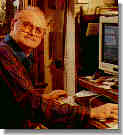
Special Topics
User-contributed essays on diverse topics
Sunday, June 17, 2001
Sections
Alt.Mail
Special Reports
This is a spinoff from the Alt.Mail page as topics are generated..
BEGIN with a discussion of Faster Than Light travel.
It appears to me, from a cursory reading of the noted site, that we may be as far from some form of FTL today as we were from the atomic bomb in the 1920s. Ideas related to those of Dr. Pournelle’s late friend Dr. Petr Beckmann appear to be involved.
http://weber.u.washington.edu/~blacky/space/abstract.htm#mass_modification
=.=.=
We are all Private Ryan
http://www.delphi.com/MicroCapitalism
-=-=-=-=-=-=-=-=-=
Astonishing. Beckmann rejected Relativity; unlike me, he had some right to an opinion on the subject. Was it James Jeans who said that the Universe is not only a queerer place than we imagine, but a queerer place than we can imagine? Whoever said it was spot on. Thanks.
(Actually JBS Haldane as several pointed out; Thanks. Now if I can figure why this thing is so WIDE-- anyone KNOW? I am sure I could find it but I'm out of time. It works fine in Preview so it's a setting in html. Ah. Found it. Mr. Erwin's "Cheers" was block indented way way over. Done.)
==
Remember the research into space-like closed curves, where it was predicted that if you spun up a massive cylinder, you could get frame dragging and use that to build a time machine? When they did a semi-classical analysis, they discovered that if you tried to spin up the cylinder you would get pair production to bleed off the angular momentum, almost like Cherenkov radiation, which would prevent the device from being built. My point is that the quantum mechanical processes that prevent FTL are likely to be statistical. You ought to be able to get FTL locally, but with vanishing probability of success for any useful distance, or—and this is key—with rapid degradation of the quality of the signal transmitted with distance. So broaden your definition of ‘successful transmission’ a bit.
Now, the quantum state of a particle has infinite support—i.e., it has a non-zero probability of existing everywhere. That underlies the phenomenon of quantum tunneling, and I understand that has been exploited in some funny experiments to perform lossy transmission of messages at faster than C. So if you’re willing to accept some noise at the destination, you may well be able to exceed C. Why might that be acceptable? Most material structures and biological systems are robust to low levels of noise—we live at about 300 degrees Kelvin for a start, and heat is as noisy as it gets. So a transmission system built of multiple repeaters may be able to move a message across a significant distance faster than C with acceptable accuracy.
What makes me think this might work? During target capture, bats are able to perceive the order of events that happen within an interval of a few hundred nanoseconds. They also may react to target movements during the last few tens of milliseconds of the capture process. They do this with neurons that spike a few times a second. Some of this is based on averaging over large numbers of neurons, but some also seems to be based on detectors that are specialized to ‘see’ the front edge of the signal when it emerges from an array of neurons. If one of those neurons happens to be in a super-sensitive state at the time the afference arrives, it will spike really fast, and the front edge detector then triggers for that spike. The result is noisy, but can be very fast.
Cheers,
Harry Erwin, Internet: herwin@gmu.edu, Web Page: http://mason.gmu.edu/~herwin Senior Software Analyst supporting the FAA, PhD candidate in computational neuroscience—modeling how bats echolocate—and lecturer for CS 211 (data structures and advanced C++).